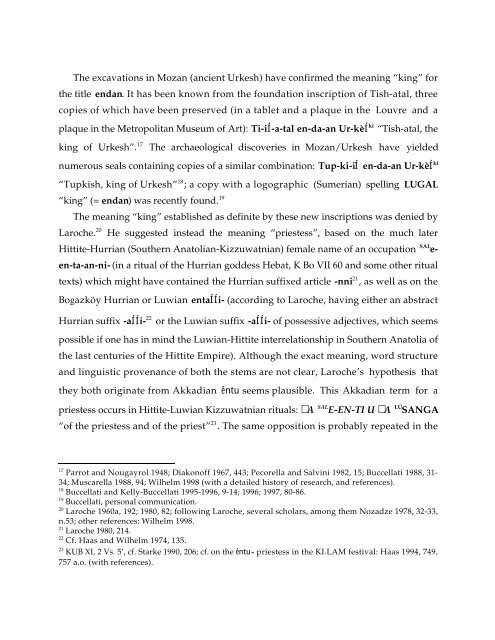Comparative Notes on Hurro-Urartian, Northern Caucasian
Comparative Notes on Hurro-Urartian, Northern Caucasian
Comparative Notes on Hurro-Urartian, Northern Caucasian
Create successful ePaper yourself
Turn your PDF publications into a flip-book with our unique Google optimized e-Paper software.
The excavati<strong>on</strong>s in Mozan (ancient Urkesh) have c<strong>on</strong>firmed the meaning “king” for<br />
the title endan. It has been known from the foundati<strong>on</strong> inscripti<strong>on</strong> of Tish-atal, three<br />
copies of which have been preserved (in a tablet and a plaque in the Louvre and a<br />
plaque in the Metropolitan Museum of Art): Ti-iÍ-a-tal en-da-an Ur-kèÍ ki “Tish-atal, the<br />
king of Urkesh”. 17 The archaeological discoveries in Mozan/Urkesh have yielded<br />
numerous seals c<strong>on</strong>taining copies of a similar combinati<strong>on</strong>: Tup-ki-iÍ en-da-an Ur-kèÍ ki<br />
“Tupkish, king of Urkesh” 18 ; a copy with a logographic (Sumerian) spelling LUGAL<br />
“king” (= endan) was recently found. 19<br />
The meaning “king” established as definite by these new inscripti<strong>on</strong>s was denied by<br />
Laroche. 20 He suggested instead the meaning “priestess”, based <strong>on</strong> the much later<br />
Hittite-Hurrian (Southern Anatolian-Kizzuwatnian) female name of an occupati<strong>on</strong> SAL e-<br />
en-ta-an-ni- (in a ritual of the Hurrian goddess Hebat, K Bo VII 60 and some other ritual<br />
texts) which might have c<strong>on</strong>tained the Hurrian suffixed article -nni 21 , as well as <strong>on</strong> the<br />
Bo azköy Hurrian or Luwian entaÍÍi- (according to Laroche, having either an abstract<br />
Hurrian suffix -aÍÍi- 22 or the Luwian suffix -aÍÍi- of possessive adjectives, which seems<br />
possible if <strong>on</strong>e has in mind the Luwian-Hittite interrelati<strong>on</strong>ship in Southern Anatolia of<br />
the last centuries of the Hittite Empire). Although the exact meaning, word structure<br />
and linguistic provenance of both the stems are not clear, Laroche’s hypothesis that<br />
they both originate from Akkadian êntu seems plausible. This Akkadian term for a<br />
priestess occurs in Hittite-Luwian Kizzuwatnian rituals: A SAL E-EN-TI U A LÚ SANGA<br />
“of the priestess and of the priest” 23 . The same oppositi<strong>on</strong> is probably repeated in the<br />
17 Parrot and Nougayrol 1948; Diak<strong>on</strong>off 1967, 443; Pecorella and Salvini 1982, 15; Buccellati 1988, 31-<br />
34; Muscarella 1988, 94; Wilhelm 1998 (with a detailed history of research, and references).<br />
18 Buccellati and Kelly-Buccellati 1995-1996, 9-14; 1996; 1997, 80-86.<br />
19 Buccellati, pers<strong>on</strong>al communicati<strong>on</strong>.<br />
20 Laroche 1960a, 192; 1980, 82; following Laroche, several scholars, am<strong>on</strong>g them Nozadze 1978, 32-33,<br />
n.53; other references: Wilhelm 1998.<br />
21 Laroche 1980, 214.<br />
22 Cf. Haas and Wilhelm 1974, 135.<br />
23 KUB XL 2 Vs. 5’, cf. Starke 1990, 206; cf. <strong>on</strong> the êntu- priestess in the KI.LAM festival: Haas 1994, 749,<br />
757 a.o. (with references).





